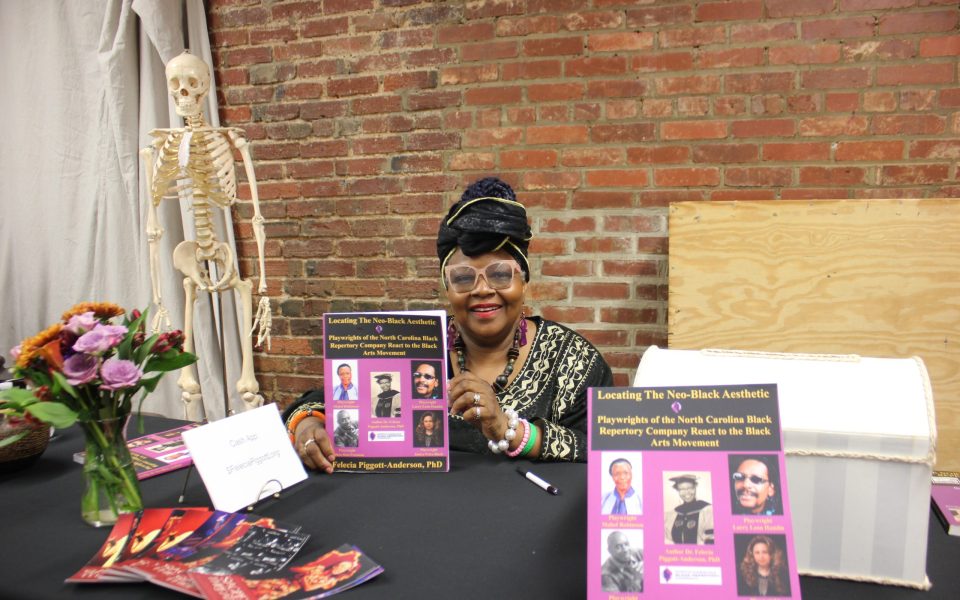Featured photo: Dr. Felecia Piggott-Anderson poses with her new book at the Oct. 8 event in Winston-Salem. (photo by Sudarshan Krishnamurthy)
The entire crowd stood on its feet, playing their various percussion instruments as they sang and danced along to the welcome song.
“Funga alafia, ashe ashe!” they shouted.
Dr. Felecia Piggott-Anderson and Baba Joseph Anderson brought drums, tambourines, and jingles for audience members to play along to the West African song and dance of welcome.
This is how the book launch and signing event for Piggott-Anderson’s newest book, Locating the Neo-Black Aesthetic: Playwrights of the North Carolina Black Repertory Company React to the Black Arts Movement started on the evening of Oct. 8 at the Sawtooth School for Visual Arts.
The event centered a deep appreciation for those past and present in the Black Arts movement. And the new book highlighted the vast history of a portion of theater that little had been written and published about before: Black theater.
“It’s an exciting day,” Piggott-Anderson shared. “It’s exciting because it gives us an opportunity to lift up our local authors, playwrights, and scholars. There’s so much unity in what’s happening today.”

Just outside the room where the book launch was taking place was the exhibition, Sacred Threads: Weaving Stories from the North Carolina Black Repertory Company, inspired by Piggott-Anderson’s first book, North Carolina Black Repertory Company: 25 Marvtastic Years, showcasing costumes, memorabilia and visual artworks from the NC Black Rep’s performing arts history.
“That someone saw the value of it and appreciated all the writing, interviews and pictures enough to make an exhibit out of it is a gift from god,” the author shared. “When I wrote the book that the exhibit is based on, I was teaching theater at Carver High School, and I knew that I wanted my students to meet the people I was writing about.”
As an educator who has been teaching at Carver High School in Winston-Salem for 22 years now, Piggot-Anderson was excited to expose her students to the arts and their history when she brought them to the exhibit.
At the launch event, Piggott-Anderson discussed the progression of the Black Arts movement.
She began by speaking of Amiri Baraka and Ed Bullins, both leading playwrights of the movement. She writes in her new book that they “serve as the standard bearers of the Black aesthetic, while the four dramatists from the NC Black Rep address the Neo-Black aesthetic.”
She also talks about four playwrights from the NC Black Rep including Larry Leon Hamlin, Nathan Ross Freeman, Mabel Robinson and Janice Price-Black.
Robinson and Price-Black, both in attendance, sat in the first row, all-smiles as they listened to Piggott-Anderson speak about their work.

Piggott-Anderson analyzed more than 40 plays to put together this seminal work, and describes in her book various features of the neo-Black aesthetic.
In her book, Piggott-Anderson ties together how Freeman and Price-Black depict Black women who gain ascendancy over patriarchal forces through expatriation, self-defense and the ‘erotic as power,’ a concept Audre Lorde develops in an essay on the topic.
Piggott-Anderson also contrasts this portrayal with Baraka’s depiction of subjugated Black women. Baraka represents women as passive and submissive, allowing themselves to be exploited and disenfranchised. However, she highlights that this did not happen in a vacuum — “sexism was commonplace in dramas of the 1960s before the rise of the Women’s Movement,” she writes.
And this distinction between the old guard of the Black arts movement and what Piggott-Anderson labels the neo-Black aesthetic had not been written about before in the context of the NC Black Repertory company, until now.
“My professor said that the research I’m doing with the neo-Black aesthetic is a work of reclamation,” Piggott-Anderson shared.
She wanted to ensure that her work in this field was in a format where it could be reproduced, and from where others could learn.
With the numerous gaps in African American history and literature, she described this work of comparing the present and the past of Black theater as a gift to the community.
“What we’re doing is giving the current generation of artists and scholars the opportunity to claim new knowledge, and to step into a comparison of the present with the past,” she said.
Dr. Felecia Piggott-Anderson’s book, Locating the Neo-Black Aesthetic: Playwrights of the North Carolina Black Repertory Company React to the Black Arts Movement, is available for purchase online.
Join the First Amendment Society, a membership that goes directly to funding TCB‘s newsroom.
We believe that reporting can save the world.
The TCB First Amendment Society recognizes the vital role of a free, unfettered press with a bundling of local experiences designed to build community, and unique engagements with our newsroom that will help you understand, and shape, local journalism’s critical role in uplifting the people in our cities.
All revenue goes directly into the newsroom as reporters’ salaries and freelance commissions.


Leave a Reply